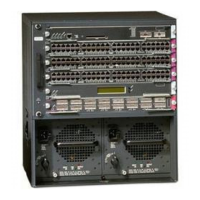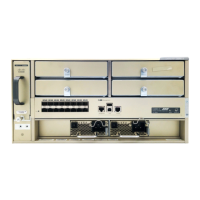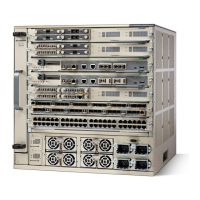8-11
Catalyst 6500 Series Switch and Cisco 7600 Series Router Firewall Services Module Configuration Guide
OL-6392-01
Chapter 8 Configuring IP Addresses, Routing, and DHCP
Configuring OSPF
View your configuration by entering the following command:
FWSM(config)# show ip ospf
Routing Process "ospf 2" with ID 20.1.89.2 and Domain ID 0.0.0.2
Supports only single TOS(TOS0) routes
Supports opaque LSA
SPF schedule delay 5 secs, Hold time between two SPFs 10 secs
Minimum LSA interval 5 secs. Minimum LSA arrival 1 secs
Number of external LSA 5. Checksum Sum 0x 26da6
Number of opaque AS LSA 0. Checksum Sum 0x 0
Number of DCbitless external and opaque AS LSA 0
Number of DoNotAge external and opaque AS LSA 0
Number of areas in this router is 1. 1 normal 0 stub 0 nssa
External flood list length 0
Area BACKBONE(0)
Number of interfaces in this area is 1
Area has no authentication
SPF algorithm executed 2 times
Area ranges are
Number of LSA 5. Checksum Sum 0x 209a3
Number of opaque link LSA 0. Checksum Sum 0x 0
Number of DCbitless LSA 0
Number of indication LSA 0
Number of DoNotAge LSA 0
Flood list length 0
Configuring OSPF Area Parameters
Single context mode only
Routed firewall mode only
You can configure several area parameters. These area parameters (shown in the following task table)
include setting authentication, defining stub areas, and assigning specific costs to the default summary
route. Authentication provides password-based protection against unauthorized access to an area.
Stub areas are areas into which information on external routes is not sent. Instead, there is a default
external route generated by the area border router, into the stub area for destinations outside the
autonomous system. To take advantage of the OSPF stub area support, default routing must be used in
the stub area. To further reduce the number of LSAs sent into a stub area, you can configure the
no-summary keyword of the area stub command on the area border router to prevent it from sending
summary link advertisement (LSAs type 3) into the stub area.
To specify area parameters for your network, follow these steps:
Step 1 If you have not already done so, enter the router configuration mode for the OSPF process you want to
configure by entering the following command:
FWSM(config)# router ospf
process_id
Step 2 Enter any of the following commands:
• To enable authentication for an OSPF area, enter the following command:
FWSM(config-router)# area
area-id
authentication
• To enable MD5 authentication for an OSPF area, enter the following command:
FWSM(config-router)# area
area-id
authentication message-digest

